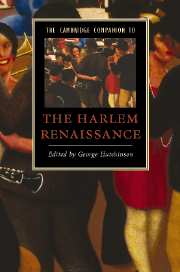Book contents
- Frontmatter
- Introduction
- Part I: Foundations of The Harlem Renaissance
- Part II: Major Authors and Texts
- 4 Negro drama and the Harlem Renaissance
- 5 Jean Toomer and the avant-garde
- 6 “To tell the truth about us”: the fictions and non-fictions of Jessie Fauset and Walter White
- 7 African American folk roots and Harlem Renaissance poetry
- 8 Lyric stars: Countee Cullen and Langston Hughes
- 9 “Perhaps Buddha is a woman”: women’s poetry in the Harlem Renaissance
- 10 Transgressive sexuality and the literature of the Harlem Renaissance
- 11 Sexual desire, modernity, and modernism in the fiction of Nella Larsen and Rudolph Fisher
- 12 Banjo meets the Dark Princess: Claude McKay, W. E. B. Du Bois, and the transnational novel of the Harlem Renaissance
- 13 The Caribbean voices of Claude McKay and Eric Walrond
- 14 George Schuyler and Wallace Thurman: two satirists of the Harlem Renaissance
- 15 Zora Neale Hurston, folk performance, and the “Margarine Negro”
- Part III: The Post-Renaissance
- Further Reading
- Index
11 - Sexual desire, modernity, and modernism in the fiction of Nella Larsen and Rudolph Fisher
from Part II: - Major Authors and Texts
Published online by Cambridge University Press: 28 July 2007
- Frontmatter
- Introduction
- Part I: Foundations of The Harlem Renaissance
- Part II: Major Authors and Texts
- 4 Negro drama and the Harlem Renaissance
- 5 Jean Toomer and the avant-garde
- 6 “To tell the truth about us”: the fictions and non-fictions of Jessie Fauset and Walter White
- 7 African American folk roots and Harlem Renaissance poetry
- 8 Lyric stars: Countee Cullen and Langston Hughes
- 9 “Perhaps Buddha is a woman”: women’s poetry in the Harlem Renaissance
- 10 Transgressive sexuality and the literature of the Harlem Renaissance
- 11 Sexual desire, modernity, and modernism in the fiction of Nella Larsen and Rudolph Fisher
- 12 Banjo meets the Dark Princess: Claude McKay, W. E. B. Du Bois, and the transnational novel of the Harlem Renaissance
- 13 The Caribbean voices of Claude McKay and Eric Walrond
- 14 George Schuyler and Wallace Thurman: two satirists of the Harlem Renaissance
- 15 Zora Neale Hurston, folk performance, and the “Margarine Negro”
- Part III: The Post-Renaissance
- Further Reading
- Index
Summary
Critics of the Harlem Renaissance often pair Nella Larsen with Jessie Fauset, but Nella Larsen and Rudolph Fisher make a better literary pair than do Fauset and Larsen. Like Claude McKay and Wallace Thurman, both Larsen and Fisher believed that sexual desire is a primary force in human nature but one shaped by the ubiquitous presence of modernity. One manifestation of modernity, of course, is popular culture - cabarets, film, and pulp fiction. And as modernists, Larsen and Fisher saw that popular culture was a source of modernism, especially American modernism. For instance, as murder mysteries, Larsen's Passing (1929) and Fisher's The Conjure Man Dies (1932) are indebted to a modernist conception that a lowbrow literary genre like a detective novel might reveal, in Raymond Chandler's famous phrase, a “hidden truth.” In Quicksand (1928), Larsen makes use of another aspect of popular culture (both cinematic and literary), the sensational story of the “tragic mulatta,” but her allusion to Hemingway's The Sun Also Rises (1926) reinterprets that story as an examination of love in a post World War I universe. Finally, in Fisher's The Conjure Man Dies, the clue to the murderer's identity lies not in rational analysis (which presupposes Newtonian order) but in a comic blues song about sexual desire heard daily on Harlem's streets. Echoing Plato's Symposium, all three novels treat sexual desire as the engine in the human machine that can either destroy the self or create the possibility for transcendence, either personal or communal.
- Type
- Chapter
- Information
- The Cambridge Companion to the Harlem Renaissance , pp. 155 - 169Publisher: Cambridge University PressPrint publication year: 2007
- 1
- Cited by



